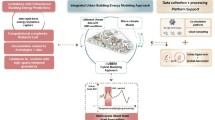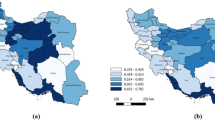Abstract
This study proposes a cellular automata-based Industrial and Residential Land Use Competition Model to simulate the dynamic spatial transformation of industrial land use in Shanghai, China. In the proposed model, land development activities in a city are delineated as competitions among different land-use types. The Hedonic Land Pricing Model is adopted to implement the competition framework. To improve simulation results, the Land Price Agglomeration Model was devised to simulate and adjust classic land price theory. A new evolutionary algorithm-based parameter estimation method was devised in place of traditional methods. Simulation results show that the proposed model closely resembles actual land transformation patterns and the model can not only simulate land development, but also redevelopment processes in metropolitan areas.

Data source: Shanghai Urban Planning and Land Resource Administration Bureau

Data source: Shanghai Urban Planning and Land Resource Administration Bureau

Data source: Shanghai Urban Planning and Land Resource Administration Bureau










Similar content being viewed by others
References
Alonso W (1964) Location and land use: toward a general theory of land rent. Harvard University Press, Cambridge
Al-shalabi M, Billa L, Pradhan B, Mansor S, Al-Sharif AA (2012) Modelling urban growth evolution and land-use changes using GIS based cellular automata and SLEUTH models: the case of Sana’a metropolitan city, Yemen. Environ Earth Sci 70(1):425–437
Anas A, Arnott R, Small KA (1998) Urban spatial structure. J Econ Lit 36(3):1426–1464
Batty M (1998) Urban evolution on the desktop: simulation with the use of extended cellular automata. Environ Plan A 30(11):1943–1967
Batty M, Hudson-Smith A (2005) Urban simulacra: London. Arch Des 75(6):42–47
Batty M, Couclelis H, Eichen M (1997) Urban systems as cellular automata. Environ Plan B Plan Des 24(2):159–164
Berry BJ (1964) Cities as systems within systems of cities. Pap Reg Sci 13(1):147–163
Bodenmann B, Axhausen K (2010) Synthesis report on the state of the art on firmographics. Institute for Transport Planning and Systems, ETH, Zurich
Boschma RA, Frenken K (2006) Applications of evolutionary economic geography. In: Frenken K (ed) Applied evolutionary economics and economic geography. Edward Elgar Publishing, Cheltenham
Boschma RA, Wenting R (2007) The spatial evolution of the British automobile industry: does location matter? Ind Corp Change 16(2):213–238
Brueckner JK (2011) Lectures on urban economics. MIT Press, Cambridge
Cervero R, Landis J (1993) Assessing the impacts of urban rail transit on local real estate markets using quasi-experimental comparisons. Transp Res Part A Policy Pract 27(1):13–22
Christodoulou A (2010) STUDI: a model to simulate the impacts of new metro lines on urban development in London. Doctoral dissertation, University College London
Clark WA, Burt JE (1980) The impact of workplace on residential relocation. Ann Assoc Am Geogr 70(1):59–66
Couclelis H (2001) Why I no longer work with agents. Paper presented at the special workshop on agent-based models of land-use, land-cover change, CSISS, Irvine. www.csiss.org/events/other/agent-based/papers/couclelis.pdf
De Bok M, Sanders F (2005) Firm relocation and accessibility of locations empirical results from the Netherlands. Transp Res Rec J Transp Res Board 1902:35–43
De Bok M, van Oort F (2011) Agglomeration economies, accessibility and the spatial choice behavior of relocating firms. J Transp Land Use 4(1):5–24
Espey M, Lopez H (2000) The impact of airport noise and proximity on residential property values. Growth Change 31(3):408–419
Fan J, Li P (2009) The scientific foundation of major function oriented zoning in China. J Geogr Sci 19(5):515–531
Fischer MM, Nijkamp P (2012) Spatial dynamics of European integration: regional and policy issues at the turn of the century. Springer, New York
Fujita M, Thisse J-F (2013) Economics of agglomeration: cities, industrial location, and globalization. Cambridge University Press, Cambridge
Garreau J (2011) Edge city: life on the new frontier. Anchor, New York
Harvey J, Jowsey E (2004) Urban land economics. Palgrave Macmillan, Basingstoke
Henderson V, Mitra A (1996) The new urban landscape: developers and edge cities. Reg Sci Urban Econ 26(6):613–643
Henley A (1994) Industrial deconcentration in UK manufacturing since 1980. Manch Sch 62(1):40–59
Hilferink M, Rietveld P (1999) Land Use Scanner: an integrated GIS based model for long term projections of land use in urban and rural areas. J Geogr Syst 1(2):155–177
Hudalah D, Viantari D, Firman T, Woltjer J (2013) Industrial land development and manufacturing deconcentration in Greater Jakarta. Urban Geogr 34(7):950–971
Irwin EG, Bockstael NE (2002) Interacting agents, spatial externalities and the evolution of residential land use patterns. J Econ Geogr 2(1):31–54
Irwin EG, Bockstael NE (2004) Land use externalities, open space preservation, and urban sprawl. Reg Sci Urban Econ 34(6):705–725
Lefcoe G (2005) Regulation of superstores: the legality of zoning ordinances emerging from the skirmishes between wal-mart and the united food and commercial workers union. Ark Law Rev 58:833
Levy S, Martens K, Heijden R (2011) An agent-based model of transport and land use policy coordination between municipalities. Paper presented at the Proc. Bijdrage aan Het Colloquium Vervoersplanologisch Speurwerk, Antwerpen (November 2011)
Lin GC (2009) Developing China: land, politics and social conditions. Routledge, Abingdon
Luo J, Wei YD (2004) A geostatistical modeling of urban land values in Milwauke, Wisconsine. Geogr Inf Sci 10(1):49–57
Marton AM, Wu W (2006) Spaces of globalisation: institutional reforms and spatial economic development in the Pudong new area, Shanghai. Habitat Int 30(2):213–229
Mieszkowski P, Mills E (1993) The causes of metropolitan suburbanization. J Econ Perspect 7(3):135–147
Moreno N, Menard A, Marceau DJ (2008) VecGCA: a vector-based geographic cellular automata model allowing geometric transformations of objects. Environ Plan 35(4):647–665
Nadiri MI, Mamuneas TP (1996) Contribution of highway capital to industry and national productivity growth. Federal Highway Administration Washington, DC, Washington, DC
Nanda A, Yeh J-H (2014) Spatio-temporal diffusion of residential land prices across Taipei regions. SpringerPlus 3(1):1
Ning Y, Yan Z (1995) The changing industrial and spatial structure in Shanghai. Urban Geogr 16(7):577–594
Parker DC, Manson SM, Janssen MA, Hoffmann MJ, Deadman P (2003) Multi-agent systems for the simulation of land-use and land-cover change: a review. Ann Assoc Am Geogr 93(2):314–337
Pellenbarg PH, Van Wissen LJ, Van Dijk J (2002) Firm relocation: state of the art and research prospects. University of Groningen, Groningen
Peng R, Wheaton WC (1994) Effects of restrictive land supply on housing in Hong Kong: an econometric analysis. J Hous Res 5(2):263
Qiu R, Xu W (2017) Modes of land development in Shanghai. Land Use Policy 61:475–486
Qiu R, Xu W, Zhang J (2015) The transformation of urban industrial land use: a quantitative method. J Urban Manag 4(1):40–52
Raymond Y (1998) Housing price, land supply and revenue from land sales. Urban Stud 35(8):1377–1392
Rose LA (1989) Urban land supply: natural and contrived restrictions. J Urban Econ 25(3):325–345
Rosenthal SS, Strange WC (2003) Geography, industrial organization, and agglomeration. Rev Econ Stat 85(2):377–393
Schotten K, Goetgeluk R, Hilferink M, Rietveld P, Scholten H (2001) Residential construction, land use and the environment. Simulations for the Netherlands using a GIS-based land use model. Environ Model Assess 6(2):133–143
Taleai M, Sharifi A, Sliuzas R, Mesgari M (2007) Evaluating the compatibility of multi-functional and intensive urban land uses. Int J Appl Earth Obs Geoinf 9(4):375–391
Teye A, Ahelegbey D (2016) Detecting spatial and temporal house price diffusion in the Netherlands: a Bayesian network approach. Available at SSRN: https://ssrn.com/abstract=2710081
Thiele JC, Kurth W, Grimm V (2012) RNETLOGO: an R package for running and exploring individual-based models implemented in NETLOGO. Methods Ecol Evol 3(3):480–483
Viehe FW (1981) Black gold suburbs the influence of the extractive industry on the suburbanization of Los Angeles, 1890–1930. J Urban Hist 8(1):3–26
Walker R (2001) Industry builds the city: the suburbanization of manufacturing in the San Francisco Bay Area, 1850–1940. J Hist Geogr 27(1):36–57
Weber A, Friedrich CJ (1962) Theory of the location of industries. University of Chicago Press Chicago, Chicago
White R, Engelen G (1993) Cellular automata and fractal urban form: a cellular modelling approach to the evolution of urban land-use patterns. Environ Plan A 25:1175–1199
White R, Uljee I, Engelen G (2012) Integrated modelling of population, employment and land-use change with a multiple activity-based variable grid cellular automaton. Int J Geogr Inf Sci 26(7):1251–1280
Wilensky U (1999) NetLogo. Center for Connected Learning and Computer-Based Modeling, Northwestern University, Evanston, IL. http://ccl.northwestern.edu/netlogo/
Willis KG, Garrod G, Harvey D (1998) A review of cost–benefit analysis as applied to the evaluation of new road proposals in the UK. Transp Res Part D Transp Environ 3(3):141–156
Wu FL (1998) Simulating urban encroachment on rural land with fuzzy-logic-controlled cellular automata in a geographical information system. J Environ Manag 53(4):293–308
Wu WP (2008) Migrant settlement and spatial distribution in metropolitan Shanghai. Prof Geogr 60(1):101–120
Wu FL, Martin D (2002) Urban expansion simulation of Southeast England using population surface modelling and cellular automata. Environ Plan A 34(10):1855–1876
Xu W (2004) The changing dynamics of land-use change in rural China: a case study of Yuhang, Zhejiang Province. Environ Plan A 36(9):1595–1615
Yeh AG, Wu FL (1996) The new land development process and urban development in Chinese cities. Int J Urban Reg Res 20(2):330–353
Zhu Y (2000) In situ urbanization in rural China: case studies from Fujian Province. Dev Change 31(2):413–434
Acknowledgements
This research was funded by the Ministry of Education of China (Grant 11JJDZH006), the Ford Foundation (0155-0883), and Globalink Research Award of Mitacs. The research was also supported by NSERC CREATE AMETHYST Program at the University of Lethbridge and the Program for Professor of Special Appointment (Eastern Scholar JZ2014006) at Shanghai Institutions of Higher Learning. We appreciate greatly the constructive comments and suggestions from anonymous reviewers.
Author information
Authors and Affiliations
Corresponding author
Rights and permissions
About this article
Cite this article
Qiu, R., Xu, W., Zhang, J. et al. Modeling and simulating industrial land-use evolution in Shanghai, China. J Geogr Syst 20, 57–83 (2018). https://doi.org/10.1007/s10109-017-0258-x
Received:
Accepted:
Published:
Issue Date:
DOI: https://doi.org/10.1007/s10109-017-0258-x
Keywords
- Urban land use
- Industrial spatial structure
- Spatial analysis
- Cellular automata
- Genetic algorithm
- Shanghai




